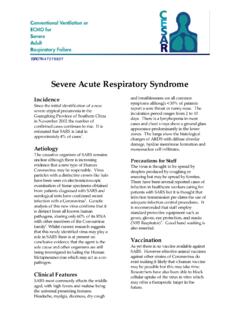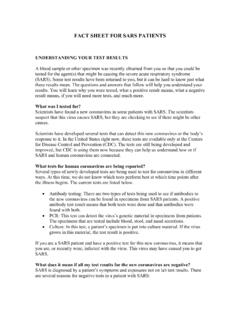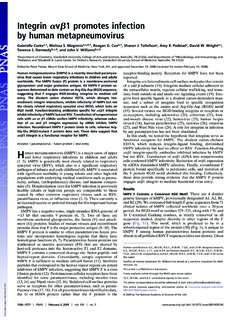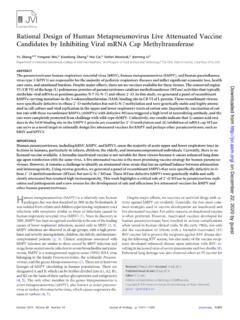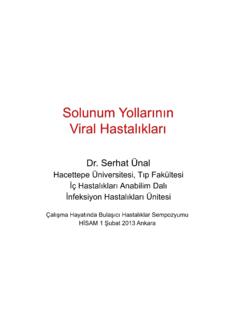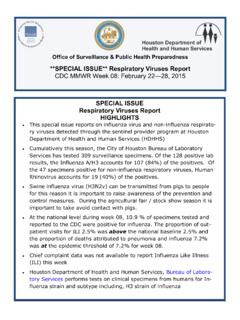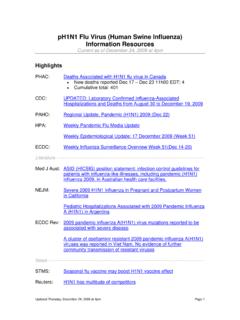Transcription of Department of Extension Family and Consumer Sciences
1 Department of Extension Family and Consumer Sciences Quarterly Newsletter October 2016 The Common Cold: A Quiz Sonja Koukel, PhD Community & Environmental Specialist When a cold hits, the most common symptoms experienced are a sore throat, runny nose, coughing, sneezing, watery eyes, headaches and body aches. Common colds are the main reason that children miss school and adults miss work.
2 Each year in the , millions of people get the common cold. Adults have an average of 2-3 colds per year, and children have even more. Quiz: How much do you know about the common cold? Respond to these True/False questions. The correct answers are provided following the quiz. 1. Antibiotics will help you recover from a cold. 2. Rhinoviruses are the most common causes of colds. 3. Colds are never serious for anyone. 4. Colds are most common in the winter and spring. 5. You can get a cold from someone by shaking their hand. Answers: 1. F - Antibiotics do not work against viruses, and they may make it harder for your body to fight future bacterial College of Agricultural, Consumer and Environmental Sciences In This Issue: The Common Cold: A Quiz Happiness Shiny Floors and Tidy Toilets?
3 How to Reduce Debt and Live within Our Means Using Credit Cards Wisely Preparing for Holiday Meals Happy Holidays! Strategies to Enjoy the Holidays by Eating Less Calories Begin to Manage Diabetes with Confidence Wearable Fitness it really help us increase our activity? The Future of the Nutrition Facts Label Introduction: Haley Nohl Detox Cleanses and Diets: Where is the Science? Extension Family & Consumer Sciences 2 Quarterly Newsletter/October 2016 infections if you take them unnecessarily. To feel better when you have a cold, you should get lots of rest and drink plenty of water. 2. T Many different viruses can cause the common cold, but rhinoviruses are the most common.
4 Rhinoviruses can also trigger asthma attacks and have been linked to sinus and ear infections. Other viruses that can cause colds include respiratory syncytial virus (RSV) a virus that infects the lungs and breathing passages. RSV is the most common cause of bronchiolitis and pneumonia in children younger than 1 year of age in the and a significant cause of respiratory illness in older adults. human parainfluenza viruses (HPIVs) a group of viruses that cause different types of respiratory infections and are most common in children and babies. Most HPIVs usually cause infections of the upper airway, such as a common cold, ear infections, or sore throat.
5 Human metapneumovirus (hMPVO) a common virus that has been responsible for respiratory illnesses for at least 50 years worldwide. 3. F See a doctor if you or your child has any of the following symptoms: temperature higher than F, symptoms that last more than 10 days, symptoms that are severe or unusual. If your child is younger than three months of age and has a fever, it s important to call your doctor right away. Most people recover from colds within about 7-10 days. However, people with weakened immune systems, asthma, or conditions that affect the lungs and breathing passages may develop serious illness, such as pneumonia. 4. T Most people get colds in the winter and spring, but it is possible to get a cold any time of the year.
6 5. T Viruses that cause colds can spread from infected people to others through the air and close personal contact this can happen when you shake hands with someone who has a cold after they have sneezed or coughed into their hands, or touch a doorknob that has viruses on it, then touch your eyes, mouth, or nose. Protect yourself and others. Wash your hands often with soap and water. If soap and water are not available, use an alcohol-based hand sanitizer. Viruses that cause colds can survive on your hands, and regular handwashing can help protect you from getting sick. Source. Happiness Shiny Floors and Tidy Toilets? Sonja Koukel, PhD Community & Environmental Specialist Shiny floors, a tidy toilet, and clean countertops make consumers the happiest.
7 ~ Brian Sansoni, Soap and Detergent Association VP of Communication What Clean Surface Makes America Smile? The first National Clean Surface Satisfaction Survey (Jan/Feb, 2008) asked 1,013 American adults (507 men and 506 women) which cleaning task makes them the happiest or gives them the most satisfaction. See if you agree with these findings: Shiny floors (21%) A tidy toilet (21%) Clean countertops (20%) A sparkling shower (15%) Gleaming windows (12%) Extension Family & Consumer Sciences 3 Quarterly Newsletter/October 2016 A spotless sink (7%) Clean mirrors (3%) Tips for Keeping a Clean and Happy Home Tread Lightly: To prevent dirt and grime from building up on floors, start by placing rugs or mats at room entrances whenever possible.
8 For a quick clean, use a dry, electrostatic dust sheet that picks up loose dust. If you have more time, use an all-in-one mop with moist, woven cloths that contain a cleaning solution to clean floors. Regularly clean wood floors with a proper wood cleaner that's tailor made for that type of surface. Counter Intuition: For effortless on-the-spot cleaning, keep wipes on the kitchen counter for easy access. Don't forget immediately after preparing raw meat, poultry or seafood, clean countertops with an antibacterial cleaner or wipe to kill unwanted germs that can make you sick. On the Surface: For clean mirrors and windows without smudges, spray glass cleaner on a soft cotton cloth instead of directly on the surface.
9 Or consider using a window wipe for an effortless clean. Scrub-A-Dub-Dub: You can keep your toilet tidy and other bathroom surfaces clean rather easily. Flushable wipes (make sure you check the label) are handy for cleaning around toilet rims, tanks, faucets, sinks and basins. Because they disperse in water when agitated (like toilet paper), they're designed to be safe for plumbing and septic tanks and the environment. Other wipe products also get the job done. You just simply dispose of them when you're finished cleaning. It s Curtains for Germs: Use a daily shower cleaner to keep shower and tub surfaces free of soap scum, mildew, and hard-water deposits. Mist the surfaces right after bathing, while surfaces are still wet.
10 For tough grime, use a surface-appropriate abrasive cleaner. There are also specific products you can use to tackle soap scum and mold and mildew. To-Do List: When choosing a cleaner for any job in the house, read and follow label directions for proper use, storage and disposal. Keep them in their original containers, with labels intact. Be sure to properly close all containers and put them away immediately, to limit accessibility to animals and children. Refer to NMSU Guide G-304, Selection and Use of Home Cleaning Products, for more information. Source. How to Reduce Debt and Live within Our Means Bryce Jorgensen, PhD Family Resource Management Specialist Everyone wants to improve their quality of life.

